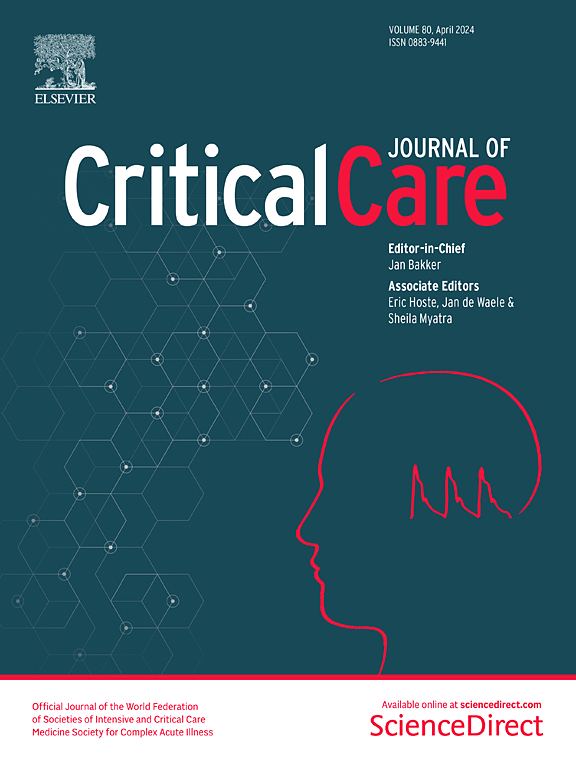ARDS患者部分支持通气时双循环呼吸叠加:仅仅是自然变异性的特征吗?
IF 8.8
1区 医学
Q1 CRITICAL CARE MEDICINE
引用次数: 0
摘要
在受控机械通气期间,双重循环与呼吸堆积(DC/BS)被认为是潜在的伤害,反映了高呼吸驱动。在部分通气支持期间,其发生可能归因于呼吸模式的生理变异性,反映了该模式的反应,而不具有特定的风险。这项交叉研究的二级分析评估了低氧血症患者在神经调节通气辅助(NAVA)、比例辅助通气(PAV +)和压力支持通气(PSV)下交叉恢复自主呼吸时的DC/BS事件。DC/BS定义为两个吸气周期伴不完全呼气。测量包括电阻抗信号、气道压力、食管和胃压力以及血流。分析呼吸变异性、动态顺应性(CLdyn)和呼气末肺阻抗(EELI)。纳入20例辅助呼吸患者,机械通气中位时间为9[5-14]天。DC/BS归因于单次(42%)或两次明显连续的吸气努力(58%)。DC/BS的中位[IQR]发生率较低:NAVA为0.6 [0.1 - 2.6]%,PAV +为0.0 [0.0 - 0.4]%,PSV为0.1 [0.0 - 0.4]% (p = 0.06)。DC/BS事件与患者潮气量变异性系数(p = 0.014)和呼吸频率(p = 0.011)相关。与常规呼吸相比,DC/BS呼吸表现出更高的潮气量、肌肉压力和区域拉伸。dc /BS周期后经常表现出EELI和CLdyn的改善,63%的病例没有呼气肌激活的证据。在部分通气支持期间,DC/BS事件并不常见,且与呼吸变异性有关。它们的频率和对肺顺应性和EELI的生理影响类似于自发性叹息,可能不被认为是先天有害的。本文章由计算机程序翻译,如有差异,请以英文原文为准。
Double cycling with breath-stacking during partial support ventilation in ARDS: Just a feature of natural variability?
Double cycling with breath-stacking (DC/BS) during controlled mechanical ventilation is considered potentially injurious, reflecting a high respiratory drive. During partial ventilatory support, its occurrence might be attributable to physiological variability of breathing patterns, reflecting the response of the mode without carrying specific risks. This secondary analysis of a crossover study evaluated DC/BS events in hypoxemic patients resuming spontaneous breathing in cross-over under neurally adjusted ventilatory assist (NAVA), proportional assist ventilation (PAV +), and pressure support ventilation (PSV). DC/BS was defined as two inspiratory cycles with incomplete exhalation. Measurements included electrical impedance signal, airway pressure, esophageal and gastric pressures, and flow. Breathing variability, dynamic compliance (CLdyn), and end-expiratory lung impedance (EELI) were analyzed. Twenty patients under assisted breathing, with a median of 9 [5–14] days on mechanical ventilation, were included. DC/BS was attributed to either a single (42%) or two apparent consecutive inspiratory efforts (58%). The median [IQR] incidence of DC/BS was low: 0.6 [0.1–2.6] % in NAVA, 0.0 [0.0–0.4] % in PAV + , and 0.1 [0.0–0.4] % in PSV (p = 0.06). DC/BS events were associated with patient’s coefficient of variability for tidal volume (p = 0.014) and respiratory rate (p = 0.011). DC/BS breaths exhibited higher tidal volume, muscular pressure and regional stretch compared to regular breaths. Post-DC/BS cycles frequently exhibited improved EELI and CLdyn, with no evidence of expiratory muscle activation in 63% of cases. DC/BS events during partial ventilatory support were infrequent and linked to breathing variability. Their frequency and physiological effects on lung compliance and EELI resemble spontaneous sighs and may not be considered a priori as harmful.
求助全文
通过发布文献求助,成功后即可免费获取论文全文。
去求助
来源期刊

Critical Care
医学-危重病医学
CiteScore
20.60
自引率
3.30%
发文量
348
审稿时长
1.5 months
期刊介绍:
Critical Care is an esteemed international medical journal that undergoes a rigorous peer-review process to maintain its high quality standards. Its primary objective is to enhance the healthcare services offered to critically ill patients. To achieve this, the journal focuses on gathering, exchanging, disseminating, and endorsing evidence-based information that is highly relevant to intensivists. By doing so, Critical Care seeks to provide a thorough and inclusive examination of the intensive care field.
 求助内容:
求助内容: 应助结果提醒方式:
应助结果提醒方式:


